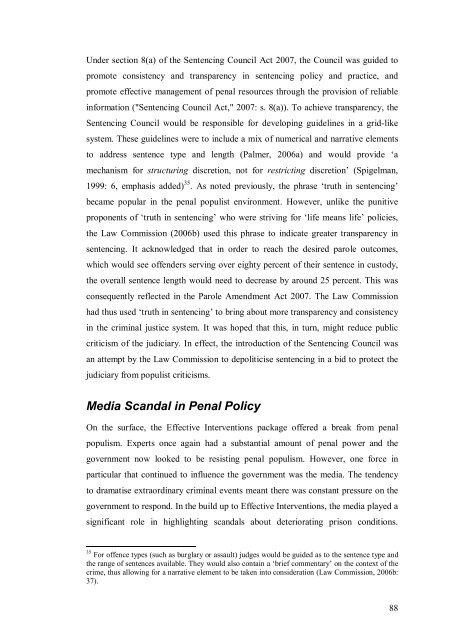By Tess Bartlett - Rethinking Crime and Punishment
By Tess Bartlett - Rethinking Crime and Punishment
By Tess Bartlett - Rethinking Crime and Punishment
You also want an ePaper? Increase the reach of your titles
YUMPU automatically turns print PDFs into web optimized ePapers that Google loves.
Under section 8(a) of the Sentencing Council Act 2007, the Council was guided topromote consistency <strong>and</strong> transparency in sentencing policy <strong>and</strong> practice, <strong>and</strong>promote effective management of penal resources through the provision of reliableinformation ("Sentencing Council Act," 2007: s. 8(a)). To achieve transparency, theSentencing Council would be responsible for developing guidelines in a gridlikesystem. These guidelines were to include a mix of numerical <strong>and</strong> narrative elementsto address sentence type <strong>and</strong> length (Palmer, 2006a) <strong>and</strong> would provide ‘amechanism for structuring discretion, not for restricting discretion’ (Spigelman,1999: 6, emphasis added) 35 . As noted previously, the phrase ‘truth in sentencing’became popular in the penal populist environment. However, unlike the punitiveproponents of ‘truth in sentencing’ who were striving for ‘life means life’ policies,the Law Commission (2006b) used this phrase to indicate greater transparency insentencing. It acknowledged that in order to reach the desired parole outcomes,which would see offenders serving over eighty percent of their sentence in custody,the overall sentence length would need to decrease by around 25 percent. This wasconsequently reflected in the Parole Amendment Act 2007. The Law Commissionhad thus used ‘truth in sentencing’ to bring about more transparency <strong>and</strong> consistencyin the criminal justice system. It was hoped that this, in turn, might reduce publiccriticism of the judiciary. In effect, the introduction of the Sentencing Council wasan attempt by the Law Commission to depoliticise sentencing in a bid to protect thejudiciary from populist criticisms.Media Sc<strong>and</strong>al in Penal PolicyOn the surface, the Effective Interventions package offered a break from penalpopulism. Experts once again had a substantial amount of penal power <strong>and</strong> thegovernment now looked to be resisting penal populism. However, one force inparticular that continued to influence the government was the media. The tendencyto dramatise extraordinary criminal events meant there was constant pressure on thegovernment to respond. In the build up to Effective Interventions, the media played asignificant role in highlighting sc<strong>and</strong>als about deteriorating prison conditions.35For offence types (such as burglary or assault) judges would be guided as to the sentence type <strong>and</strong>the range of sentences available. They would also contain a ‘brief commentary’ on the context of thecrime, thus allowing for a narrative element to be taken into consideration (Law Commission, 2006b:37).88
















